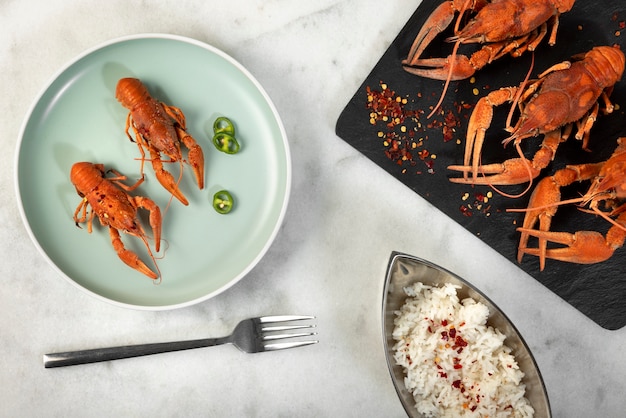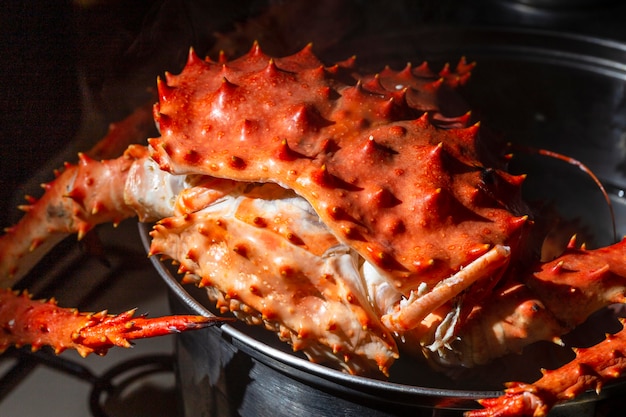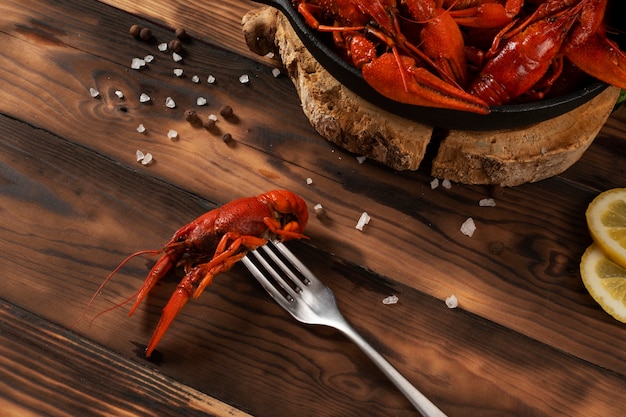Part 1: The Allure of the Dungeness

There's something about Dungeness crabs that just makes my heart sing. Maybe it's those fierce, spiky legs and that little face, always looking like it's plotting its next daring escape. Or maybe it's the incredible flavour, that delicate sweetness and hint of saltiness that's like a taste of the ocean itself. I remember the first time I truly fell in love with Dungeness crab. We were on a trip to the coast of Oregon, and my friend's dad, a seasoned fisherman, had just caught a basketful. He steamed them up, and the whole cabin filled with that delicious aroma. We sat around the table, cracking open those beauties, and it was pure bliss. The meat, so succulent and sweet, practically melted in my mouth. Since then, I've been hooked. Dungeness crabs are a real treat, and they deserve to be cooked with care and respect, and enjoyed with the utmost appreciation.
Part 2: Cooking Methods – Steam vs. Boil

There are two main ways to cook Dungeness crabs – steaming and boiling. Each method has its own advantages and disadvantages, so it really comes down to personal preference. Let's take a closer look.
2.1 Steaming: A Gentle Touch for Delicate Flavors
I'm a huge fan of steaming. It's a gentle way to cook the crab, allowing the natural flavours to shine through. Think of it like a spa day for your crab, where it gets pampered with the soft embrace of steam. You simply place the crab in a steamer basket over a pot of boiling water, and let the steam do its magic. The downside is that it can take a bit longer, but the wait is well worth it. The meat will be incredibly tender and juicy, with a beautiful, delicate texture.
2.2 Boiling: The Classic, Fast-Paced Approach
Boiling is the more traditional method, and it's definitely quicker. You simply drop the crab into a large pot of boiling water and let it cook until done. It's a classic for a reason, but there are a few things to keep in mind. Boiling can sometimes toughen the crab meat a bit, but you can counteract this by adding a splash of vinegar to the water. The vinegar helps to acidify the water, which in turn helps to prevent the meat from becoming rubbery. Another tip is to use cold water when boiling, and bring it to a boil with the crab already in the pot. This helps to ensure that the crab cooks evenly.
Part 3: Sizing Up Your Crab: A Matter of Time

One of the most important factors to consider when cooking Dungeness crabs is their size. A bigger crab will take longer to cook than a smaller one. As a rule of thumb, you should allow about 10 minutes per pound of crab meat, plus an extra 5 minutes for the first pound. So, a 2-pound crab would need to cook for around 25 minutes. But remember, these are just guidelines. It's always a good idea to check for doneness, which we'll discuss in detail later.
Part 4: Timing is Everything
Now, let's talk about those cooking times in more detail. Remember, the goal is to cook the crab until the meat is firm and white, but still tender and juicy. Overcooked crab meat can become tough and rubbery, so it's always better to err on the side of undercooking. Here's a more detailed guide based on both steaming and boiling methods:
4.1 Steaming Times
Steaming is generally a bit slower than boiling, allowing for more gentle cooking and the preservation of delicate flavors. Here's a rough guideline for steaming times, adjusted for different crab sizes:
| Size (lb) | Steaming Time (minutes) |
|---|---|
| 1 | 15-20 |
| 2 | 25-30 |
| 3 | 35-40 |
| 4+ | 45-50+ (add 10 minutes per additional pound) |
4.2 Boiling Times
Boiling is a quicker method but requires a bit more attention to ensure the crab cooks evenly. Here's a breakdown for boiling times:
| Size (lb) | Boiling Time (minutes) |
|---|---|
| 1 | 10-15 |
| 2 | 20-25 |
| 3 | 30-35 |
| 4+ | 40-45+ (add 10 minutes per additional pound) |
Remember, these times are just a starting point. It's best to check for doneness using the methods we'll discuss in the next section. And always prioritize quality over speed, because when it comes to Dungeness crab, patience truly pays off.
Part 5: Checking for Doneness: Signs of a Perfect Crab
So, how do you know when your Dungeness crab is ready to be cracked open and enjoyed? Here are a few foolproof ways to check for doneness:
5.1 The Shell Test: A Visual Cue
The easiest way to check is by looking at the shell. When the crab is cooked, the shell will turn a bright, vibrant red colour. It's a beautiful signal that the crab is ready to be enjoyed! If the shell is still a dull grey or brown, it needs a little more time. You can also try to insert a skewer or toothpick into the thickest part of the leg. If it slides in easily, then the crab is cooked. But if it feels stiff or resists, give it a few more minutes.
5.2 The Meat Test: Flaky and Tender
Another way to check for doneness is to examine the meat itself. Once the crab is cooked, the meat should be firm and white, and it should flake easily when you pull it apart. If the meat is still translucent or pink, then it needs to cook for a bit longer. Just remember, it's always better to err on the side of slightly undercooked meat, as overcooked crab can become tough and lose its delicate texture.
Part 6: The Art of Cracking: Unleashing the Treasures Inside
Now, it's time for the fun part – cracking open your Dungeness crab! This is where the real reward comes in, so it's important to have the right tools and techniques. Let's crack into it!
6.1 Tools of the Trade: The Essential Equipment
You'll need a few tools to crack open a Dungeness crab properly. A good pair of crab crackers is essential, as they give you the leverage you need to break through those tough shells. You'll also need a small fork or knife for picking out the delicate meat. If you don't have any special tools, don't worry – you can use a heavy knife or even a sturdy piece of wood. Just be careful! Remember, safety first.
6.2 The Cracking Technique: Precision and Patience
Cracking open a Dungeness crab can be a bit of an art form. Here's a step-by-step guide:
- Crack the Main Body: Start by cracking the main body shell in half. Place the crab on a sturdy surface, and use your crab crackers to carefully pry open the shell. Don't be afraid to use a bit of force, but be sure to work slowly and carefully.
- Crack the Legs: Next, crack the legs open. Position the leg on the cutting board, and use the crackers to carefully break the shell. Work your way down the leg, cracking each section individually.
- Crack the Claws: The claws are the most challenging part, but they're also packed with the most delicious meat. Place the claw on the cutting board, and use the crackers to break the shell. You may need to apply a bit more force here, but be careful not to crush the meat inside.
- Extract the Meat: Once you've cracked open the shell, use a fork or knife to gently pick out the meat. The meat in the legs is quite delicate, so handle it with care.
Remember, take your time and enjoy the process. Cracking open a Dungeness crab is a part of the experience, a way to connect with the tradition of enjoying this magnificent crustacean. So, relax, have fun, and revel in the delicious results.
Part 7: A Feast of Flavors: Savoring the Sweetness of the Sea
Once you've cracked open your Dungeness crab, it's time to savor the rewards. The meat is incredibly versatile and can be enjoyed in many different ways. Here are some tips and ideas to inspire your culinary creativity:
7.1 The Simple Delights: Nature's Perfect Flavors
The most basic, yet most satisfying way to enjoy Dungeness crab meat is simply as is. Let the sweet, briny flavors of the ocean dance on your tongue. A squeeze of fresh lemon juice, a drizzle of high-quality olive oil, and a sprinkle of fresh herbs can enhance those natural flavors, creating a symphony of taste.
7.2 Building a Crab Feast: Adding Depth and Complexity
If you want to get a bit more creative, there are endless possibilities for incorporating Dungeness crab into your meals. Here are some ideas to get you started:
- Dungeness Crab Cakes: A classic for a reason! These cakes are packed with crab meat, herbs, and spices, and they're perfect for a light lunch or dinner. Served with a creamy remoulade sauce, they're truly divine.
- Dungeness Crab Pasta: A simple yet satisfying dish that's perfect for a quick and easy meal. Just toss cooked Dungeness crab meat with your favourite pasta, olive oil, garlic, and a sprinkle of Parmesan cheese. The flavors blend beautifully, and the dish comes together in minutes.
- Dungeness Crab Salad: A fresh and flavourful salad that's perfect for a summer picnic or a light lunch. Combine Dungeness crab meat with avocado, cucumber, tomatoes, and a light vinaigrette. The combination of textures and flavors is simply irresistible.
- Dungeness Crab Tacos: A unique and delicious twist on traditional tacos. Fill soft corn tortillas with Dungeness crab meat, mango salsa, and a dollop of sour cream. The combination of sweet and spicy flavors is truly unforgettable.
Part 8: FAQs: Answering Your Burning Questions
Let's tackle those burning questions you might have about Dungeness crabs.
8.1 What's the Best Way to Store a Fresh Crab?
Fresh Dungeness crabs should be stored in the refrigerator, preferably on a bed of ice. They'll stay fresh for a few days, but it's best to cook them as soon as possible for the best flavour. If you need to freeze your crabs, wrap them tightly in plastic wrap or aluminum foil. They can be stored in the freezer for up to 3 months. However, freezing can affect the texture of the meat, so it's best to enjoy them fresh if possible.
8.2 Can You Cook a Crab in the Oven?
You can, but it's not the most common method. If you do choose to bake your crab, make sure to wrap it tightly in aluminum foil to keep the moisture in. Bake it at 400 degrees Fahrenheit for around 20-25 minutes, or until the shell is bright red. However, steaming or boiling are generally preferred methods for cooking Dungeness crabs.
8.3 What's the Difference Between Dungeness Crab and King Crab?
Dungeness crabs are smaller than King crabs, and they have a more delicate, sweet flavour. King crabs have a more robust flavour and a firmer texture. Both are delicious, but they're best suited for different dishes. Dungeness crab is often enjoyed in its natural form, while King crab is more commonly used in dishes like legs or claws, which are perfect for steaming or grilling.
8.4 What Are Some Delicious Recipes Using Dungeness Crab?
There are so many delicious recipes using Dungeness crab! From simple salads to decadent pasta dishes, the possibilities are endless. Here are a few more ideas to get you started:
- Dungeness Crab Bisque: A creamy and comforting soup that's perfect for a chilly evening. Blend cooked Dungeness crab meat with cream, butter, and herbs for a truly luxurious soup.
- Dungeness Crab Quiche: A perfect brunch or light lunch option. Combine cooked Dungeness crab meat with eggs, cream, and cheese for a savory quiche that's both delicious and impressive.
8.5 What Should I Do with the Tomalley?
The tomalley, the green substance inside the body cavity of the crab, is a delicacy for many. It has a strong, briny flavor and a creamy texture. You can eat it as is or add it to dishes like crab cakes or pasta sauces. Tomalley adds a depth of flavor that many find irresistible, but remember, it's an acquired taste.
Part 9: The Final Word: A Celebration of Flavors
There you have it, my friends! A complete guide to cooking Dungeness crabs like a pro. Remember, the key to success is using fresh, high-quality crabs, and getting the cooking times right. Don't be afraid to experiment with different flavour combinations, and have fun! Happy cracking, and enjoy the sweet, salty treasures of the Dungeness crab!
Everyone is watching

How to Cook Frozen Lobster Tails Perfectly: A Step-by-Step Guide
RecipesLobster. Just the word conjures up images of lavish meals, special occasions, and a taste of luxury. But let's...

Pigs in a Blanket Cooking Time: How Long to Bake for Perfect Results
RecipesAh, pigs in a blanket. Just the name conjures up images of those delightful little parcels of crispy pastry en...

Pork Fillet Cooking Time: How Long to Cook It Perfectly
RecipesPork fillet, or tenderloin as it's sometimes called, is a real favourite in our house. It's so versatile, and...

The Ultimate Guide to Cooking Delicious Frankfurters
RecipesLet's face it, we all love a good frankfurter. It's a classic, simple, and always satisfying. But let's be rea...

Wolf Meat Recipes: A Guide to Cooking Wild Game
RecipesLet's be honest, you don't see wolf meat at your local butcher shop every day. It's a bit of a wild card, but ...
